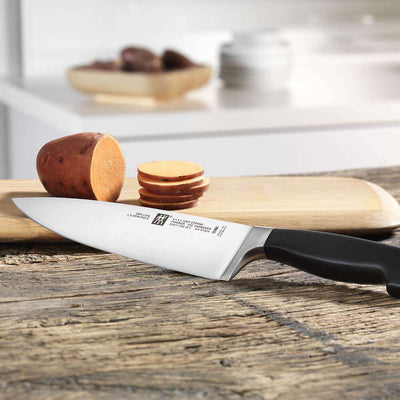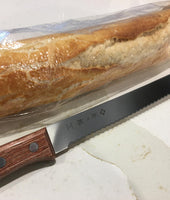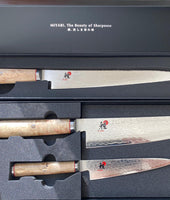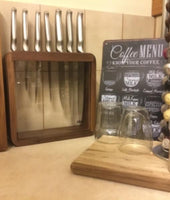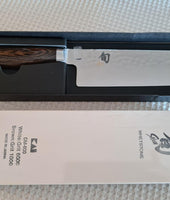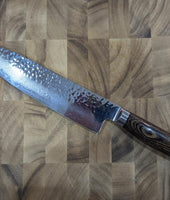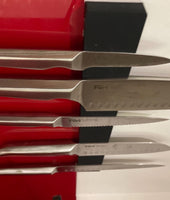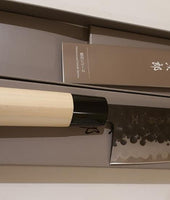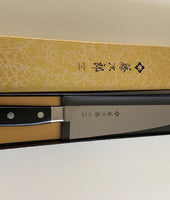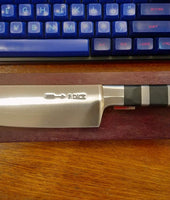Are you looking for a real knife for your kitchen? The market is loaded with knives in all shapes and sizes, and it can get confusing when trying to work out which one is best for you. Any good chef knows the importance of a good knife when it comes to preparing food to perfection, so it’s important to choose the correct one for your needs.
The two most common options when it comes to kitchen knives are German and Japanese knives. It’s the great debate: which one is superior to the other? However, you shouldn’t just jump in and make a decision without knowing the facts. The last thing you want to do is invest in a knife only for you to realise that it won’t perform the way you want it to.
The correct knife is an invaluable piece of equipment in the kitchen. The right knife allows you to:
- Ensure the texture of the food is right - you can damage or bruise the piece of food you’re chopping, which can affect the taste
- Ensure the food you’re cutting is equal - if each piece isn’t cut the same way, smaller pieces will cook much quicker than bigger pieces. The result is an undercooked and overcooked dish
- Work efficiently and safely
It’s for these reasons that we are placing a huge emphasis on the right tools. That’s why we have compared Japanese vs. German kitchen knives for you. Read on to find out the pros and cons of both and what their unique characteristics are to help you make an informed decision before making a purchase.
Usage
There are two different styles of kitchen knives: Japanese kitchen knives are recommended for the delicate slicing and finer work, whereas German knives are the kitchen workhorses. German knives usually tend to be heavier and thicker. They are designed with a rounded belly, fatter profile and are recommended as best all-purpose knives.
German knives can handle tough jobs with ease; you can use them on joints and bones. On the flip side, Japanese knives are more suitable for precise cutting or chopping jobs. They are designed with thinner blades and demand more attention during usage.

Friedr Dick Premier Plus Range (German Knives)
Blade Angle
German knives are generally designed with a wider blade angle; in most of these kitchen knife sets, you may find an angle of 17.5 degrees. Whereas, the blade on Japanese knives generally have an angle somewhere between 10 to 15 degrees on each side.
Note that, the angle of the blade decides the level of sharpness for a knife. The smaller the angle, the sharper the knife, the narrower the cutting path allowing for cleaner cuts without damaging the food along the cut.
Depending on the knife, generally it is harder to achieve high level precision cuts with German knives compared to their Japanese counterparts; however, they are usually more stronger and robust, better suited when cutting through tough items.
Design
German knives usually come with a full-tang and a bolster. Full-tang indicates the blade starts from the tip of the knife and continues to the end of the handle and the bolster is the thickest part of steel located right before the handle giving it additional strength when chopping tougher vegetables compared to other knives.
Japanese knives more often than not, have no bolster and the tangs vary between knife makers. This makes the knife much lighter and versatile to use.

Shun Classic Range (Japanese Knives)
Steel
Both Japanese and German knives are designed using steel blades, but each steel may be composed of slightly different properties and in different proportions which may lend if more flexibility, hardness, durability, sharpness and so on.
Steel is an alloy composed of iron and carbon. The amount of carbon in a piece of steel directly correlates to hardness and inversely correlates to durability. Due to a difference in forging techniques, Japanese steel blades contain much more carbon than German blades, making them harder, but also more fragile. Because Japanese-style steel is harder, it’s capable of holding an edge longer and doesn’t need to be sharpened quite as often as German knives do.
Hardness
The Rockwell scale is industry-standard used when defining steel hardness, and on this scale, Japanese knives score somewhere between 60 to 63, whereas German knives are 57.
Although a higher score and greater hardness on the surface sounds better, a steel’s hardness isn’t everything. A Rockwell hardness over 58 will provide the sharpest edge retention but requires greater care as they can chip and break if dropped or misused. Knives with a lower Rockwell score are therefore less likely to chip and break, can handle more abuse but will require honing and sharpening on a more regular basis.
Construction
Most German knives have a full-tang construction, which means that a single piece of steel runs from blade to butt. Japanese blades taper inside the handle, making for a lighter, front-weighted knife to enable more controlled movements.
In Conclusion
In short, if you want to perform any delicate task like slicing sashimi or a tomato, using a good quality Japanese knife would be better for the job. You will be able to make precise and finer cuts effortlessly and gracefully.
With German knives, you can expect thicker and stronger blades which are more robust and will handle the toughest jobs, such as cutting through pumpkins, watermelons, thick cuts of meat etc. However you’ll need to regularly hone and sharpen them to keep the edge of the blade sharp.
Want the best knives in the world? House of Knives has them right here, at competitive prices for you. Because when it comes down to it, we don’t stock anything less than the best, which is why Japanese knives and German knives both come out equal when it comes to the perfect combination of quality craftsmanship, premium design and high-grade materials.
Shop now to see our range of premium German knives and Japanese knives.

Also Read: Shun Knives Australia - What Makes Them So Sharp, Light & Comfortable
Explore More Products: Musashi Blue Steel #2 Rosewood Chef Knife 21cm | Musashi Blue Steel #2 Rosewood Paring Knife 13.5cm | Musashi Blue Steel #2 Rosewood Sujihiki Slicing Knife 27cm | Musashi Chopsticks Honyaki Stainless Dawn Handle 15cm





















